
Danes, Heruls, Angles and Jutes
Saxo Grammaticus starts “Saxonis Grammatici Historia Danica” with: “Dan and Angel, Humble’s sons, from whom the Danish originate, was our people’s founders, although the French chronicle-writer Dudo will know that the Danes descend from the Greeks or, as they are also called, the Danas, and got their name from them.”

Saxo Grammaticus by Louis Moe.
This is probably not absolutely true but shows Saxo’s purpose of his work, namely, to create a history of Denmark that could unite the nation by creating or strengthening a common Danish identity.
Jordanes wrote that Dani expelled Herulos from their settlements, which we must believe, lay in Denmark. The Heruls are mentioned by many ancient writers, but they are not found in any written sources from Scandinavia, neither at Snorre, Saxo or in other sagas, old English poems or in any other handed down histories.
It must, therefore, be assumed that they were known in Scandinavia under a different name. Nobody knows for sure, who they were, and there is ample room for guesses and speculations. But it is tempting to think that they were the direct descendants of the dominating people in the old Bronze Age culture that still held out on Sjælland and in Skåne, until they were expelled by Dani. The Danish archaeologist Johannes Brøndsted noted that Sjælland and neighboring islands are strikingly poor in finds from the oldest Iron Age, it is as if the bronze age here continued yet another time, he argued.
Dana meant River or Estuary
Many believe that “danu” is an ancient proto-Indo-European word for river.
The Romans used mostly the Greek Ister for Danube, but Tacitus wrote Danubius. Pliny wrote: “Magnum est stare in Danubii ripa” meaning: “It’s magnificent to stand on the banks of the Danube”. In English and French, the river is still called Danube.
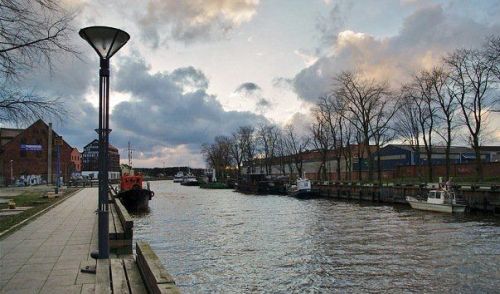 |
The river Dana through Klaipeda in Lithuania. Photo curiositu.ru.
In “The saga of Hervarar and King Heidrek” the Gothic capital is called Arheimar and is located at the Danpar river that is the Dnieper, which was also called Danapris or Danaper of Greeks and Romans. Dniester was in ancient times called Danastius or Danaster.
In the description of a Sclaweni people, the Antes, who lived in southern Ukraine between the rivers Dniestr and Dniepr, Jordanes calls the two rivers respectively Danastro and Danaprum (a Danastro extenduntur usque the Danaprum).
The river Don is called Tanais, among others by Strabo, and thus it is called also in Heimskringla by Snorre. Procopius tells that the Po River in northern Italy was called either Po or Eridanos. The French river Rhone is called Rodanus by several ancient writers, for example in “Historia Langobardorum” by Paul the Deacon, where we hear about some marauding Saxons, who came to the Rodanus river.
The river that runs through Klaipeda in Lithuania is called simply Dana, and is said that there are six rivers in the UK, called Don. It is also said that on Jacob Langebek’s maps from around 1755 the river Eider is called Døne.
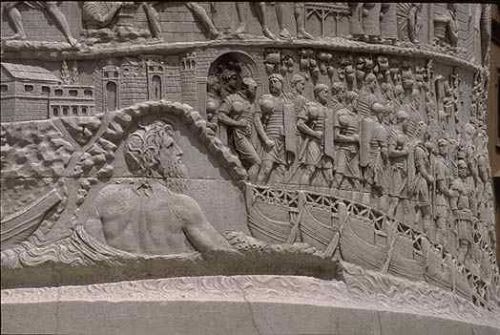
A relief on Trajan’s Column depicting the god Danubius watching Roman legionaries – Wikipedia.
Plinius (23-79 AC) wrote in Naturalis Historia: “There is the extremely great mountains Saevo not inferior to the high crags of Riphaeus, which make up a very large gulf called Codanus as far as to the Cimbrians’ Promontory, and it is full of islands, of which the most well known is Scandinavia, the magnitude whereof is not yet discovered.” At about the same time Pomponius Mela (died around 45 AD) wrote on Codanus Sinus and Codannovia, which was a large island in Codanus Sinus. Most assume that “sinus” means bay.
The same Pliny the Elder wrote: “Pytheas says that Gutones, a people in Germania, inhabits the banks of an estuary of the ocean called Mentonomon.” As the Goths really lived in southern Scandinavia, we must believe that he thought that the Danish straits and the Baltic Sea was a large estuary.
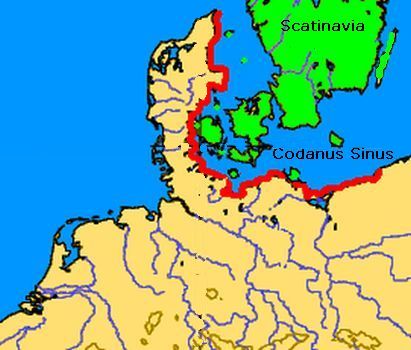
Pytheas says that the Gutones, a people in Germania, inhabits the banks of an estuary of the ocean called Mentonomon. Their territory extends over a distance of six thousand stadia (about 1.100 kilometers). From Wikipedia.
At first glance, we imagine that Codanus most likely was Latin, because it sounds Latin and Pliny and Mela wrote in Latin; but it is not. An online Latin-Danish dictionary gives the answer that Codan means “in Danish”, and it was probably not the intention.
It’s pretty likely that Codanus was the name of the inner Danish waters understood as a river or estuary in an original proto Indo-European language, like Eridanos, Rodanos and all the other river names that can be traced back to the term “dana” for “river” in an original language that probably was spoken from southern Russia to France and Scandinavia, most likely dating back to the Bronze Age. When Pliny and Mela wrote that the bay or estuary is called Codanus, then it was not a Latin name that they had given it, but more likely it was, what the inhabitants of the area called it themselves.
The ending -us in Codanhus is a mere gender- and casus-suffix.
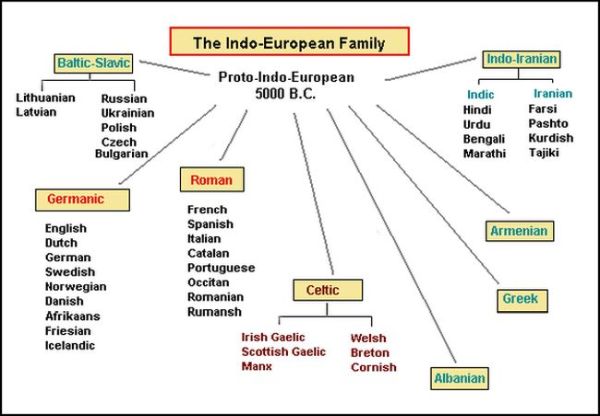 |
It is assumed that the Indo-European languages originate from an original proto Indo-European language. From Site for Language Management in Canada.
Many believe that Lithuanian is the modern language that is most close to an original Proto-Indo-European language. Lithuanians add -as to men’s names to indicate that this person is a man, quite like the Romans added -us to men’s names, like in Julius, Crassus, Augustus and so on.
I remember a former colleague, who strived to learn Lithuanian; he thought it was not so difficult, because many words recall corresponding Danish words.
But when dana, danu, dan, danos or danus meant river, what meant then “Co-“?
We recognize co- in many modern words denoting collaboration or cooperation between several agents, for example, company, coordinate, corporation – Codanus could then have meant something like “cooperating rivers”, which is not a bad description of the three Danish straits, which spew brackish water into the Western Ocean.
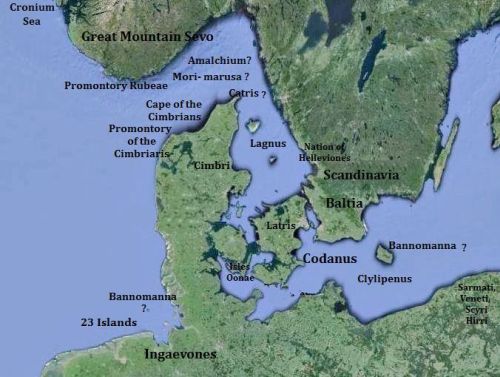 |
A traditional interpretation of Pliny’s place names.
In the “Naturalis Historia” section on the Baltic Sea, Southern Scandinavia and the North Sea, Pliny the Elder gives additional examples of names that may have originated in an original proto Indo-European language that was spoken in these parts of the World: “The rest of these coasts are only known in detail by reports of doubtful authority. To the north is the ocean; beyond the river Parapanisus, where it washes the coast of Scythia. Hecataeus calls it the Amalchian Sea, a name that in the language of the natives means “frozen”; Philemon says that the Cimbrian name for it is Morimarusa (that is “Dead Sea”) from the Parapanisus to Cape Rusbeae, and from that point onward the Cronian Sea. Xenophon of Lampsacus reports that three days’ sail from the Scythian coast there is an island of enormous size called Balcia; Pytheas gives its name as Basilia. Also, some islands called the Oeonae are reported of which the inhabitants live on birds’ eggs and oats.” These names are not Latin names, which the Romans have given islands and seas, but names that the people of these regions used themselves. Apart from “Oeonae” which recalls the Danish “ø” meaning island, they do not remind of Gothic or Germanic names.
Saxo wrote: “Dudo will know that the Danes descend from the Greeks or, as they also are called the Danas, and got their name from them.” But Greece reminds geographically on Denmark since it consists of a peninsula and numerous islands, where in between are flowing streams of less salty water from the many rivers that flow into the Black Sea; therefore, the country’s inhabitants were in a remote antiquity also called Danas in an original Indo-European language.
Homer called the Greeks for Danaans or Danai. When the Greeks had left the walls of Troy and left behind their wooden horse, the priest Laocoon said: “I fear Dana’ans, even those who bring gifts.”

OFFICIAL AND REGISTEREDL CLAN CARRUTHERS CCIS SINCE 1983-CLAN OF OUR ANCESTORS
SCOTTISH CLAN – IRISH CLAN – NORSE CLAN
Preserving Our Past! Recording Our Present! Informing Our Future!
The Ancient and Honorable Carruthers Clan International Society LLC
CLANCARRUTHERS1@GMAIL.COM

CLAN CARRUTHERS INT SOCIETY CCIS HISTORIAN AND GENEALOGIST

You can find us on our main facebook pages at :
SILVER WINGS-https://www.facebook.com/CarruthersClanLLC/
GOLD WINGS – https://www.facebook.com/carrutherscarrothers.pat.9
CLAN CARRUTHERS FAMILY HISTORY – https://www.facebook.com/CarruthersClan
CLAN CARRUTHERS CCIS – https://www.facebook.com/groups/3878691252182714
CLAN CARRUTHERS INT SOCIETY- https://www.facebook.com/groups/394653845137709
CLAN CARRUTHERS – BORDER REIVERS – https://www.facebook.com/groups/434959914239094
Disclaimer Ancient and Honorable Carruthers Clan International Socie


